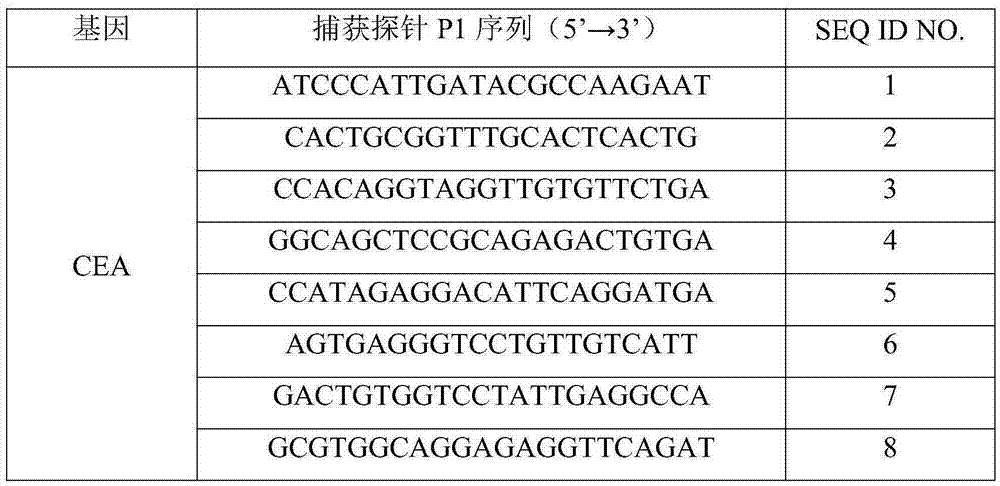Circulating gastric tumor cell identifying kit
A technology for tumor cells and gastric cancer cells, applied in the field of molecular biology, can solve the problems of missed treatment opportunities, contaminated blood samples, insufficient operation rate, etc., and achieve the effect of improving accuracy and reliability and improving accuracy.
- Summary
- Abstract
- Description
- Claims
- Application Information
AI Technical Summary
Problems solved by technology
Method used
Image
Examples
Embodiment 1
[0041] There are two types of gastric cancer circulating tumor cell identification kits described in this example, those with labeled probes and those without labeled probes.
[0042] Among them, the gastric cancer circulating tumor cell identification kit A with labeled probes mainly includes:
[0043] 1. Capture probe
[0044] The capture probe consists of three parts, from the 5' end to the 3' sequence is the sequence P1 that is complementary to the mRNA of the corresponding marker gene, the spacer sequence, and the P2 sequence that is complementary to the corresponding amplification probe P3 sequence, the same category The P2 sequences in the capture probes of the marker genes are the same. The spacer is used to space the capture probe P2 sequence from the target mRNA, and by setting a spacer sequence of appropriate length inside the probe, it can reduce steric hindrance, improve the efficiency of the hybridization reaction and the specificity of the hybridization reactio...
Embodiment 2
[0073] Example 2 Using kit A in Example 1 to detect circulating tumor cells in peripheral blood of patients with gastric cancer
[0074] The formula of described various solutions is as follows:
[0075]
[0076]
[0077] The probe mixture, amplification mixture, and chromogenic mixture in this example all use all the probes in the corresponding gene list in Example 1 (including all marker genes being CEA, HER2, KRT7, KRT8, KRT17, KRT18, KRT19, KRT20, AKT2, HIF-1A, TWIST1, VIMENTIN, CD45).
[0078] 1. Sample pretreatment, filtering gastric cancer CTCs onto the filter membrane
[0079] 1. Preserve the blood sample in the sample preservation tube with preservation solution, centrifuge at 600×g for 5 minutes, discard the supernatant, and remove the red blood cells.
[0080] 2. Add 4ml of PBS and 1ml of fixative, vortex to mix, and let stand at room temperature for 8min.
[0081] 3. Sample filtration: transfer the liquid in the sample storage tube to the filter, turn on t...
Embodiment 3
[0140] Example 3 Using the kit A in Example 1 to detect gastric cancer cell lines
[0141] 1. Selection of cell lines
[0142] The gastric cancer cell marker genes of the kit of the present invention are selected from: one or more of CEA and HER2; epithelial cell marker genes are selected from: one or more of KRT7, KRT8, KRT17, KRT18, KRT19, KRT20; mesenchymal cell markers The gene is selected from: one or more of AKT2, HIF-1A, TWIST1, VIMENTIN; the leukocyte marker gene is CD45. The various marker genes in gastric cancer cell marker genes, epithelial cell marker genes, mesenchymal cell marker genes and leukocyte marker genes selected in the present invention are the genes specifically expressed on gastric cancer CTCs obtained by the inventor through a large number of experiments and statistical analysis and screening. , has good specificity and accuracy in the detection of gastric cancer cells.
[0143] In this example, the mixed epithelial-mesenchymal gastric cancer cell l...
PUM
 Login to View More
Login to View More Abstract
Description
Claims
Application Information
 Login to View More
Login to View More - R&D
- Intellectual Property
- Life Sciences
- Materials
- Tech Scout
- Unparalleled Data Quality
- Higher Quality Content
- 60% Fewer Hallucinations
Browse by: Latest US Patents, China's latest patents, Technical Efficacy Thesaurus, Application Domain, Technology Topic, Popular Technical Reports.
© 2025 PatSnap. All rights reserved.Legal|Privacy policy|Modern Slavery Act Transparency Statement|Sitemap|About US| Contact US: help@patsnap.com



